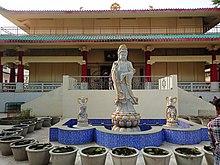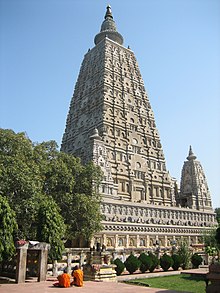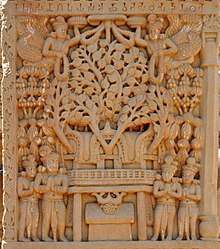Bodh Gaya
Bodh Gayā is a religious site and place of pilgrimage associated with the Mahabodhi Temple complex, situated in the Gaya district in the Indian state of Bihar.
[4] Bodh Gayā and the nearby regions were invaded and destroyed in the 12th century CE by Muslim Turk armies, led by Delhi Sultanate's Qutb al-Din Aibak and Bakhtiyar Khilji.
[citation needed] For Buddhists, Bodh Gayā is the most important of the four main pilgrimage sites related to the life of Gautama Buddha,[5] the other three being Kushinagar, Lumbini, and Sarnath.
Then he discovered the Noble Eightfold Path of his own and practiced it, finally reaching enlightenment: complete freedom from lust (raga), hatred (dvesha), and delusion (moha).
At this point, the Buddha was abandoned by the five men who had been his companions in his earlier austerities, as all they saw was an ordinary man; mocking his well-nourished appearance, they said, "Here comes the mendicant Gautama, who has turned away from asceticism.
[citation needed] Gautama's disciples began to visit the place during the full moon in the month of Vaisakh (April–May), as per the Hindu calendar.
[13] During the 12th century, Muslim Turk armies led by Delhi Sultanate's Qutb al-Din Aibak and Bakhtiyar Khilji invaded and destroyed Bodh Gayā and nearby regions.
In approximately 250 BCE, about 200 years after the Buddha attained Enlightenment, Emperor Asoka visited Bodh Gayā to establish a monastery and shrine there.
[16] Kittisirimegha of Sri Lanka, a contemporary of Samudragupta, erected with his permission a Sanghārāma near the Mahabodhi Temple, chiefly for the use of the Singhalese monks who went to worship the Bodhi tree.
The stupa was dedicated to the milkmaid Sujata, who is said to have fed the Buddha milk and rice as he was sitting under a Banyan tree, ending his seven years of fasting and asceticism and allowing him to attain illumination through the Middle Way.
[18][19][20] The stupa was built in the 2nd century BCE, as confirmed by finds of black polished wares and punch-marked coins in the attending monastery.
This temple commemorates the pivotal moment when Sujata, a village woman, offered Siddhartha a bowl of rice milk, providing him with nourishment after years of severe asceticism.
Under the slogan "Spread Buddha's rays to the Whole World", Daijokyo[clarification needed] spent seven years constructing the statue, mobilizing 120,000 masons.
[24][25] On 1 June 2018, a special National Investigation Agency (NIA) court of Patna sentenced five suspects in the case to life imprisonment.







